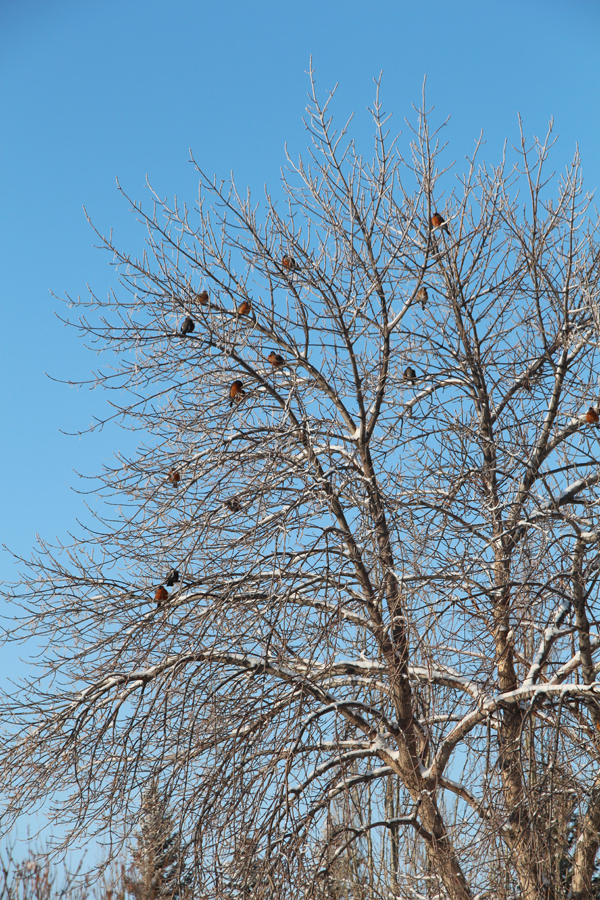(~4 minutes to read)

For several days around the end of March, this group (round?) of American Robins hung out in a tree just beyond our back fence. This is a phenomenon we’ve not noticed before in the 24 years we’ve lived in our house.
Online searches and enquiries among friends yielded two theories. The first is that the birds move north with rising temperatures and hang out in roosts until the temperature rises enough for them to move further north. The second is that the birds are just sitting there scoping out their territories.
With the naked eye, we thought they were all looking at us. Narcissism on our part? Or paranoia? (We’ve seen Hitchcock’s movie…). But in the pictures that I took, some were looking north (towards us) while others were looking south. It struck me that despite all the wise opinions we received, I knew what was really happening.
“What’s with the white stuff?” said Dave, to no one in particular. “It should’ve mostly gone by now.”
“Beats me,” said Ken, who happened to be roosting nearby Dave. “Here it is, March 31st, and there’s still 50cm of snow everywhere.”
“Where are we?” asked Steve.
“50.715997 degrees of latitude,” replied Dave, who acted as the flock’s navigator. “I don’t understand it. The grass should be greening up nicely by now.”
“Or at least we’d be able to see berries on the ground. But look at it. We’d be digging for ages,” said Ken.
“And that’s not men’s work. We need the women here for that,” he added.
“What do you think guys?” chirped Ray, who seemed to be taking the lead in the tree. “North, south or stay put?”
There was a murmur as the birds conferred. A couple flew above the tree for a short while, trying to get a bird’s-eye view of the landscape. The frigid wind hitting their under-wing area forced them back to the tree.
“Northwards, there’s no sign of anything but white,” offered Zac, fluffing up his feathers to try and get warm again.
“Ditto south,” said Henry, shivering from the hypothermia setting in in his wingpits.
“The average daily temperature is supposed to be at least three degrees wherever we go,” said Ken. Any idea what it is here at the moment?”
“Exactly three degrees,” replied Dave, who had all the data at his wingtips.
“Fahrenheit or Celsius?” asked Ray.
“Fahrenheit,” replied Dave.
“You bloody birdbrain!” scolded Ray. “We migrate behind the three-degree Celsius temperatures, not Fahrenheit! No wonder we’re freezing our wotsits off!”
“Sorry!” said Dave. “I thought that being as we’re American robins, we’d use the Fahrenheit system. Phil, my mentor, told me to keep us just south of the three-degree line, and I just assumed he meant Fahrenheit.”
“It’s an easy mistake to make,” said Steve. “We may live in Canada during the rumpy-pumpy season, but we are American robins.”
“Look mate,” said Ray, “Americans in Canada use the Celsius system. Canadians in the US use the Fahrenheit system. Just out of interest, where were you when Phil told you about the three-degree rule?”
“Canada,” said Dave sounding really guilty.
Henry tried doing a face-palm. Unfortunately, his wingtip was no substitute for the palm of a hand and he poked himself in the eye with a feather and fell off his perch.
“Okay guys,” yelled Ray. “We’re headed south. Dave here cocked up royally. We need to get back to where it’s warm enough.”
“But I’m hungry,” whined Steve.
“Too bad,” said Ray. “There’s squat to eat here. The sooner we get going, the sooner we can find somewhere the ground’s thawed out and we can get some worms.”
“Mmmmm… meat…” said Ken, his saliva freezing the instant it left his beak.
“How far back do we have to go till we can expect to at least find berries?” asked Steve.
“Couple of hundred miles,” said Dave.
“Where. Are. We?” said Ray menacingly, showing the place where teeth would be if birds were dentally blessed.
“50.715997 deg…”
“Which damned country!?”
“Oh… uh… Canada…”
“Does Canada use miles for measurement?”
“No-o-o-… but all the roads are laid out in square mile grids, and that’s what we see when we’re flying…”
“But they use kilometres!” exploded Ray.
“So why didn’t they tear up all the roads in 1977 and lay new ones when they went metric?”
“I won’t dignify that question with a response,” said Ray contemptuously. “Now, if we’re ready…”
“What if we pass the ladies on the way back?” asked Henry, having nursed his eye back to sufficient health to clamber back into the tree.
“We won’t,” said Ray with authority. “They don’t have Dodo Dave here navigating for them. They’ll still be w-a-a-y south.”
“And in any case,” he added, “if there’s any doubt in their minds, they’ll explain their problem and ask for directions.”
By lunchtime, our tree was bird-free. Clearly, Ray had taken charge of the situation.
Whether or not Dave continued as the flock’s navigator will remain a mystery to me. But I suspect he’d mentored a few other American robin navigators, because the tree was bird-filled again a few days later.
And it was snowing.
